Interference Aware Resource Control for 6G-Enabled Expanded IoT Networks
Abstract
1. Introduction
Contributions and Outcomes
- A cell-free IoT network is proposed that supports the enormous wireless nodes with uniform coverage and QoS.
- An interference-aware scheduling algorithm is proposed that offers optimal resource management by associating APs to the nodes optimally using designed pilot allocation.
- The mathematical formulations are obtained for the achieved spectral efficiency under different precoding schemes for different cell-free operations.
- The system is evaluated for performance in terms of spectral efficiency achieved for different number of communication nodes, pilot lengths and precoding methods.
- The proposed cell-free network with the proposed scheduling mechanism is compared with other system models, one incorporating random scheduling and other not incorporating any scheduling.
2. System Model
2.1. Pilot Transmission and Channel Estimation
2.2. Data Transmission
3. Interference-Aware Scheduling of APs and Nodes
Proposed Algorithm
| Algorithm 1:Interference-aware scheduling algorithm |
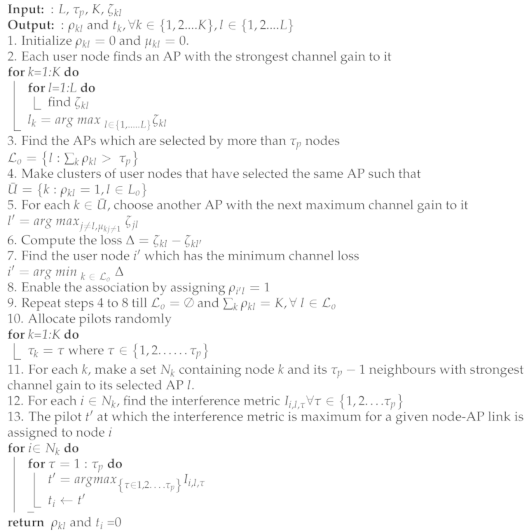 |
4. Results and Discussion
5. Conclusions
Author Contributions
Funding
Institutional Review Board Statement
Informed Consent Statement
Data Availability Statement
Conflicts of Interest
Abbreviations
| 5G | Fifth generation |
| 6G | Sixth generation |
| IoT | Internet of Things |
| AP | Access points |
| UE | User equipment |
| CPU | Central processing unit |
| IRSs | Intelligent reflecting surfaces |
| MIMO | Multiple input multiple output |
| SWIPT | Simultaneous wireless information and power transfer |
| NMSE | Normalized mean square error |
| SE | Spectral efficiency |
| QoS | Quality of service |
| SINR | Signal-to-noise-plus-interference ratio |
| CDF | Cumulative distribution function |
| MR | Maximal ratio |
| PRZF | Partial regularized zero forcing |
| LPMMSE | Local partial minimum mean square error |
| PMMSE | Partial minimum mean square error |
References
- Vaezi, M.; Azari, A.; Khosravirad, S.R.; Shirvanimoghaddam, M.; Azari, M.M.; Chasaki, D.; Popovski, P. Cellular, Wide-Area, and Non-Terrestrial IoT: A Survey on 5G Advances and the Road Towards 6G. IEEE Commun. Surv. Tutor. 2022, 24, 1117–1174. [Google Scholar] [CrossRef]
- Nguyen, T.D.; Khan, J.Y.; Ngo, D.T. A Distributed Energy-Harvesting-Aware Routing Algorithm for Heterogeneous IoT Networks. IEEE Trans. Green Commun. Netw. 2018, 2, 1115–1127. [Google Scholar] [CrossRef]
- Albouq, S.S.; Sen, A.A.A.; Almashf, N.; Yamin, M.; Alshanqiti, A.; Bahbouh, N.M. A Survey of Interoperability Challenges and Solutions for Dealing With Them in IoT Environment. IEEE Access 2022, 10, 36416–36428. [Google Scholar] [CrossRef]
- Iqbal, W.; Abbas, H.; Daneshmand, M.; Rauf, B.; Bangash, Y.A. An In-Depth Analysis of IoT Security Requirements, Challenges, and Their Countermeasures via Software-Defined Security. IEEE Internet Things J. 2020, 7, 10250–10276. [Google Scholar] [CrossRef]
- Saluja, D.; Singh, R.; Saluja, N.; Kumar, S. Energy-efficient strategy for improving coverage and rate using hybrid vehicular networks. IEEE Trans. Intell. Transp. Syst. 2020, 23, 430–443. [Google Scholar] [CrossRef]
- Moya Osorio, D.P.; Ahmad, I.; Sánchez, J.D.V.; Gurtov, A.; Scholliers, J.; Kutila, M.; Porambage, P. Towards 6G-Enabled Internet of Vehicles: Security and Privacy. IEEE Open J. Commun. Soc. 2022, 3, 82–105. [Google Scholar] [CrossRef]
- Nekovee, M. Transformation from 5G for Verticals Towards a 6G-enabled Internet of Verticals. In Proceedings of the 2022 14th International Conference on COMmunication Systems NETworkS (COMSNETS), Bangalore, India, 4–8 January 2022; pp. 1–6. [Google Scholar] [CrossRef]
- Zhang, J.; Björnson, E.; Matthaiou, M.; Ng, D.W.K.; Yang, H.; Love, D.J. Prospective Multiple Antenna Technologies for Beyond 5G. IEEE J. Sel. Areas Commun. 2020, 38, 1637–1660. [Google Scholar] [CrossRef]
- Taneja, A.; Rani, S.; Alhudhaif, A.; Koundal, D.; Gündüz, E.S. An optimized scheme for energy efficient wireless communication via intelligent reflecting surfaces. Expert Syst. Appl. 2022, 190, 116106. [Google Scholar] [CrossRef]
- Zhang, Q.; Yang, H.H.; Quek, T.Q.S.; Lee, J. Heterogeneous Cellular Networks With LoS and NLoS Transmissions—The Role of Massive MIMO and Small Cells. IEEE Trans. Wirel. Commun. 2017, 16, 7996–8010. [Google Scholar] [CrossRef]
- Saluja, D.; Singh, R.; Saluja, N.; Kumar, S. Connectivity Improvement of Hybrid Millimeter Wave and Microwave Vehicular Networks. IEEE Trans. Intell. Transp. Syst. 2022, 24, 1456–1464. [Google Scholar] [CrossRef]
- Jiang, H.; Mukherjee, M.; Zhou, J.; Lloret, J. Channel Modeling and Characteristics for 6G Wireless Communications. IEEE Netw. 2021, 35, 296–303. [Google Scholar] [CrossRef]
- Wang, C.X.; Huang, J.; Wang, H.; Gao, X.; You, X.; Hao, Y. 6G Wireless Channel Measurements and Models: Trends and Challenges. IEEE Veh. Technol. Mag. 2020, 15, 22–32. [Google Scholar] [CrossRef]
- Jain, I.K.; Kumar, R.; Panwar, S.S. The Impact of Mobile Blockers on Millimeter Wave Cellular Systems. IEEE J. Sel. Areas Commun. 2019, 37, 854–868. [Google Scholar] [CrossRef]
- Zhang, J.; Dai, L.; Li, X.; Liu, Y.; Hanzo, L. On Low-Resolution ADCs in Practical 5G Millimeter-Wave Massive MIMO Systems. IEEE Commun. Mag. 2018, 56, 205–211. [Google Scholar] [CrossRef]
- Ammar, H.A.; Adve, R.; Shahbazpanahi, S.; Boudreau, G.; Srinivas, K.V. User-Centric Cell-Free Massive MIMO Networks: A Survey of Opportunities, Challenges and Solutions. IEEE Commun. Surv. Tutor. 2022, 24, 611–652. [Google Scholar] [CrossRef]
- Tan, L.; Zhang, Z.; Wang, D. Performance of Multiuser Downlink Cell-Free Massive MIMO Systems with Hard Deadlines. IEEE Access 2022, 10, 62910–62919. [Google Scholar] [CrossRef]
- Zhou, M.; Li, J.; Xie, M.; Zhang, C.; Yuan, J. Average Sum Rate of D2D Underlaid Multigroup Multicast Cell-Free Massive MIMO With Multi-Antenna Users. IEEE Wirel. Commun. Lett. 2023, 12, 60–64. [Google Scholar] [CrossRef]
- Chen, S.; Zhang, J.; Björnson, E.; Zhang, J.; Ai, B. Structured Massive Access for Scalable Cell-Free Massive MIMO Systems. IEEE J. Sel. Areas Commun. 2021, 39, 1086–1100. [Google Scholar] [CrossRef]
- Björnson, E.; Sanguinetti, L.; Wymeersch, H.; Hoydis, J.; Marzetta, T.L. Massive MIMO is a reality—What is next?: Five promising research directions for antenna arrays. Digit. Signal Process. 2019, 94, 3–20. [Google Scholar] [CrossRef]
- Björnson, E.; Hoydis, J.; Sanguinetti, L. Massive MIMO networks: Spectral, energy, and hardware efficiency. Found. Trends Signal Process. 2017, 11, 154–655. [Google Scholar] [CrossRef]
- Sanguinetti, L.; Björnson, E.; Hoydis, J. Toward Massive MIMO 2.0: Understanding Spatial Correlation, Interference Suppression, and Pilot Contamination. IEEE Trans. Commun. 2020, 68, 232–257. [Google Scholar] [CrossRef]
- Zhang, J.; Chen, S.; Lin, Y.; Zheng, J.; Ai, B.; Hanzo, L. Cell-Free Massive MIMO: A New Next-Generation Paradigm. IEEE Access 2019, 7, 99878–99888. [Google Scholar] [CrossRef]
- Buzzi, S.; D’Andrea, C.; Zappone, A.; D’Elia, C. User-Centric 5G Cellular Networks: Resource Allocation and Comparison With the Cell-Free Massive MIMO Approach. IEEE Trans. Wirel. Commun. 2020, 19, 1250–1264. [Google Scholar] [CrossRef]
- Balachandran, K.; Kang, J.H.; Karakayali, K.M.; Rege, K.M. Network-centric cooperation schemes for uplink interference management in cellular networks. Bell Labs Tech. J. 2013, 18, 23–36. [Google Scholar] [CrossRef]
- Peng, M.; Sun, Y.; Li, X.; Mao, Z.; Wang, C. Recent Advances in Cloud Radio Access Networks: System Architectures, Key Techniques, and Open Issues. IEEE Commun. Surv. Tutor. 2016, 18, 2282–2308. [Google Scholar] [CrossRef]
- Interdonato, G.; Frenger, P.; Larsson, E.G. Scalability Aspects of Cell-Free Massive MIMO. In Proceedings of the ICC 2019—2019 IEEE International Conference on Communications (ICC), Shanghai, China, 20–24 May 2019; pp. 1–6. [Google Scholar] [CrossRef]
- Chen, S.; Zhang, J.; Zhang, J.; Björnson, E.; Ai, B. A survey on user-centric cell-free massive MIMO systems. Digit. Commun. Netw. 2022, 8, 695–719. [Google Scholar] [CrossRef]
- Ngo, H.Q.; Ashikhmin, A.; Yang, H.; Larsson, E.G.; Marzetta, T.L. Cell-Free Massive MIMO Versus Small Cells. IEEE Trans. Wirel. Commun. 2017, 16, 1834–1850. [Google Scholar] [CrossRef]
- Mai, T.C.; Ngo, H.Q.; Duong, T.Q. Downlink Spectral Efficiency of Cell-Free Massive MIMO Systems With Multi-Antenna Users. IEEE Trans. Commun. 2020, 68, 4803–4815. [Google Scholar] [CrossRef]
- Burr, A.; Islam, S.; Zhao, J.; Bashar, M. Cell-free Massive MIMO with multi-antenna access points and user terminals. In Proceedings of the 2020 54th Asilomar Conference on Signals, Systems, and Computers, Pacific Grove, CA, USA, 1–4 November 2020; pp. 821–825. [Google Scholar] [CrossRef]
- Mai, T.C.; Quoc Ngo, H.; Duong, T.Q. Cell-free massive MIMO systems with multi-antenna users. In Proceedings of the 2018 IEEE Global Conference on Signal and Information Processing (GlobalSIP), Anaheim, CA, USA, 26–29 November 2018; pp. 828–832. [Google Scholar] [CrossRef]
- Yan, H.; Ashikhmin, A.; Yang, H. A Scalable and Energy-Efficient IoT System Supported by Cell-Free Massive MIMO. IEEE Internet Things J. 2021, 8, 14705–14718. [Google Scholar] [CrossRef]
- Chen, S.; Zhang, J.; Jin, Y.; Ai, B. Wireless powered IoE for 6G: Massive access meets scalable cell-free massive MIMO. China Commun. 2020, 17, 92–109. [Google Scholar] [CrossRef]
- Zhang, Y.; Xia, W.; Zhao, H.; Xu, W.; Wong, K.K.; Yang, L. Cell-Free IoT Networks with SWIPT: Performance Analysis and Power Control. IEEE Internet Things J. 2022, 9, 13780–13793. [Google Scholar] [CrossRef]
- Wang, H.; Wang, J.; Fang, J. Grant-Free Massive Connectivity in Massive MIMO Systems: Collocated Versus Cell-Free. IEEE Wirel. Commun. Lett. 2021, 10, 634–638. [Google Scholar] [CrossRef]
- Yang, H.; Marzetta, T.L. Energy Efficiency of Massive MIMO: Cell-Free vs. Cellular. In Proceedings of the 2018 IEEE 87th Vehicular Technology Conference (VTC Spring), Porto, Portugal, 3–6 June 2018; pp. 1–5. [Google Scholar] [CrossRef]
- Ngo, H.Q.; Tran, L.N.; Duong, T.Q.; Matthaiou, M.; Larsson, E.G. On the Total Energy Efficiency of Cell-Free Massive MIMO. IEEE Trans. Green Commun. Netw. 2018, 2, 25–39. [Google Scholar] [CrossRef]
- Nayebi, E.; Ashikhmin, A.; Marzetta, T.L.; Yang, H.; Rao, B.D. Precoding and Power Optimization in Cell-Free Massive MIMO Systems. IEEE Trans. Wirel. Commun. 2017, 16, 4445–4459. [Google Scholar] [CrossRef]
- Ngo, H.Q.; Tataria, H.; Matthaiou, M.; Jin, S.; Larsson, E.G. On the Performance of Cell-Free Massive MIMO in Ricean Fading. In Proceedings of the 2018 52nd Asilomar Conference on Signals, Systems, and Computers, Pacific Grove, CA, USA, 28–31 October 2018; pp. 980–984. [Google Scholar] [CrossRef]
- Özdogan, Ö.; Björnson, E.; Zhang, J. Performance of Cell-Free Massive MIMO With Rician Fading and Phase Shifts. IEEE Trans. Wirel. Commun. 2019, 18, 5299–5315. [Google Scholar] [CrossRef]
- Björnson, E.; Sanguinetti, L. A New Look at Cell-Free Massive MIMO: Making It Practical with Dynamic Cooperation. In Proceedings of the 2019 IEEE 30th Annual International Symposium on Personal, Indoor and Mobile Radio Communications (PIMRC), Istanbul, Turkey, 8–11 September 2019; pp. 1–6. [Google Scholar] [CrossRef]
- Björnson, E.; Sanguinetti, L. Making Cell-Free Massive MIMO Competitive with MMSE Processing and Centralized Implementation. IEEE Trans. Wirel. Commun. 2020, 19, 77–90. [Google Scholar] [CrossRef]
- Interdonato, G.; Karlsson, M.; Björnson, E.; Larsson, E.G. Local Partial Zero-Forcing Precoding for Cell-Free Massive MIMO. IEEE Trans. Wirel. Commun. 2020, 19, 4758–4774. [Google Scholar] [CrossRef]
- Nayebi, E.; Ashikhmin, A.; Marzetta, T.L.; Rao, B.D. Performance of cell-free massive MIMO systems with MMSE and LSFD receivers. In Proceedings of the 2016 50th Asilomar Conference on Signals, Systems and Computers, Pacific Grove, CA, USA, 6–9 November 2016; pp. 203–207. [Google Scholar] [CrossRef]
- Attarifar, M.; Abbasfar, A.; Lozano, A. Modified Conjugate Beamforming for Cell-Free Massive MIMO. IEEE Wirel. Commun. Lett. 2019, 8, 616–619. [Google Scholar] [CrossRef]
- Guenach, M.; Gorji, A.A.; Bourdoux, A. Joint Power Control and Access Point Scheduling in Fronthaul-Constrained Uplink Cell-Free Massive MIMO Systems. IEEE Trans. Commun. 2021, 69, 2709–2722. [Google Scholar] [CrossRef]
- Tang, J.; Liu, G.; Pan, Q. A Review on Representative Swarm Intelligence Algorithms for Solving Optimization Problems: Applications and Trends. IEEE/CAA J. Autom. Sin. 2021, 8, 1627–1643. [Google Scholar] [CrossRef]
- Tang, J.; Chen, X.; Zhu, X.; Zhu, F. Dynamic Reallocation Model of Multiple Unmanned Aerial Vehicle Tasks in Emergent Adjustment Scenarios. IEEE Trans. Aerosp. Electron. Syst. 2023, 59, 1139–1155. [Google Scholar] [CrossRef]
- 3GPP. Further Advancements for E-UTRA Physical Layer Aspects (Release 9). 3GPP Technical Specification 36.814. 2017. Available online: https://portal.3gpp.org/desktopmodules/Specifications/SpecificationDetails.aspx?specificationId=2493 (accessed on 25 March 2023).
- Taneja, A.; Saluja, N. Linear precoding with user and transmit antenna selection. Wirel. Pers. Commun. 2019, 109, 1631–1644. [Google Scholar] [CrossRef]
- Demir, Ö.T.; Björnson, E.; Sanguinetti, L. Foundations of user-centric cell-free massive MIMO. Found. Trends® Signal Process. 2021, 14, 162–472. [Google Scholar] [CrossRef]
- Ando, K.; Iimori, H.; Takahashi, T.; Ishibashi, K.; De Abreu, G.T.F. Uplink Signal Detection for Scalable Cell-Free Massive MIMO Systems With Robustness to Rate-Limited Fronthaul. IEEE Access 2021, 9, 102770–102782. [Google Scholar] [CrossRef]
- Bacha, M.; Di Renzo, M.; Clerckx, B. Treating Interference as Noise in Cellular Networks: A Stochastic Geometry Approach. IEEE Trans. Wirel. Commun. 2020, 19, 1918–1932. [Google Scholar] [CrossRef]
- The MathWorks Inc. MATLAB, version: 9.13.0 (R2022b); The MathWorks Inc.: Natick, MA, USA, 2022. [Google Scholar]
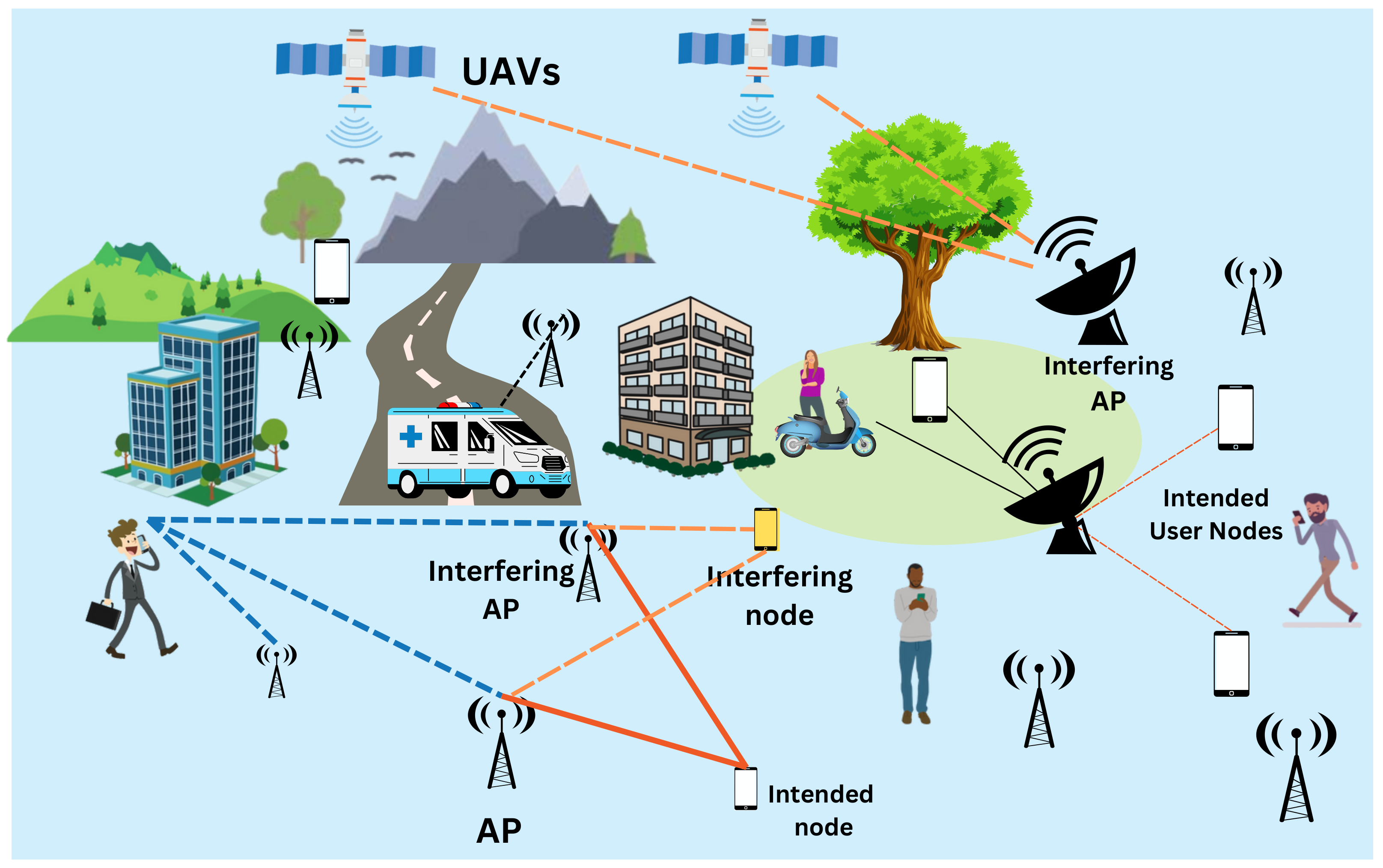
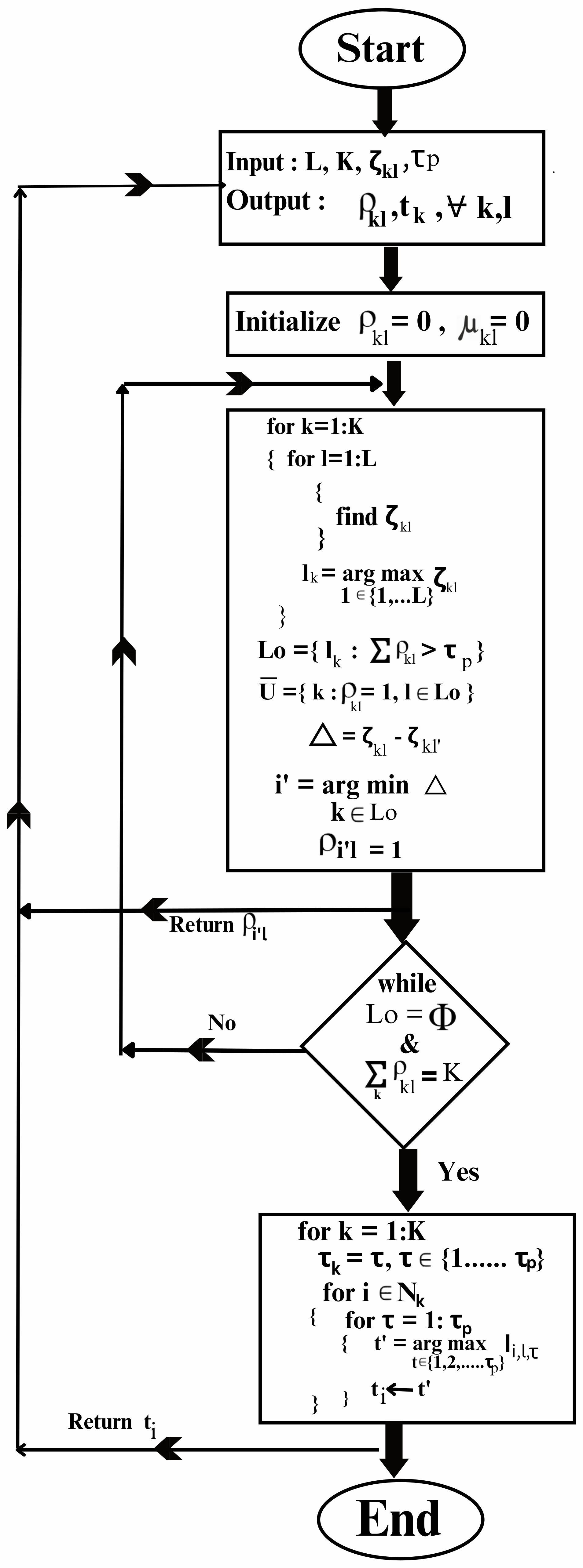
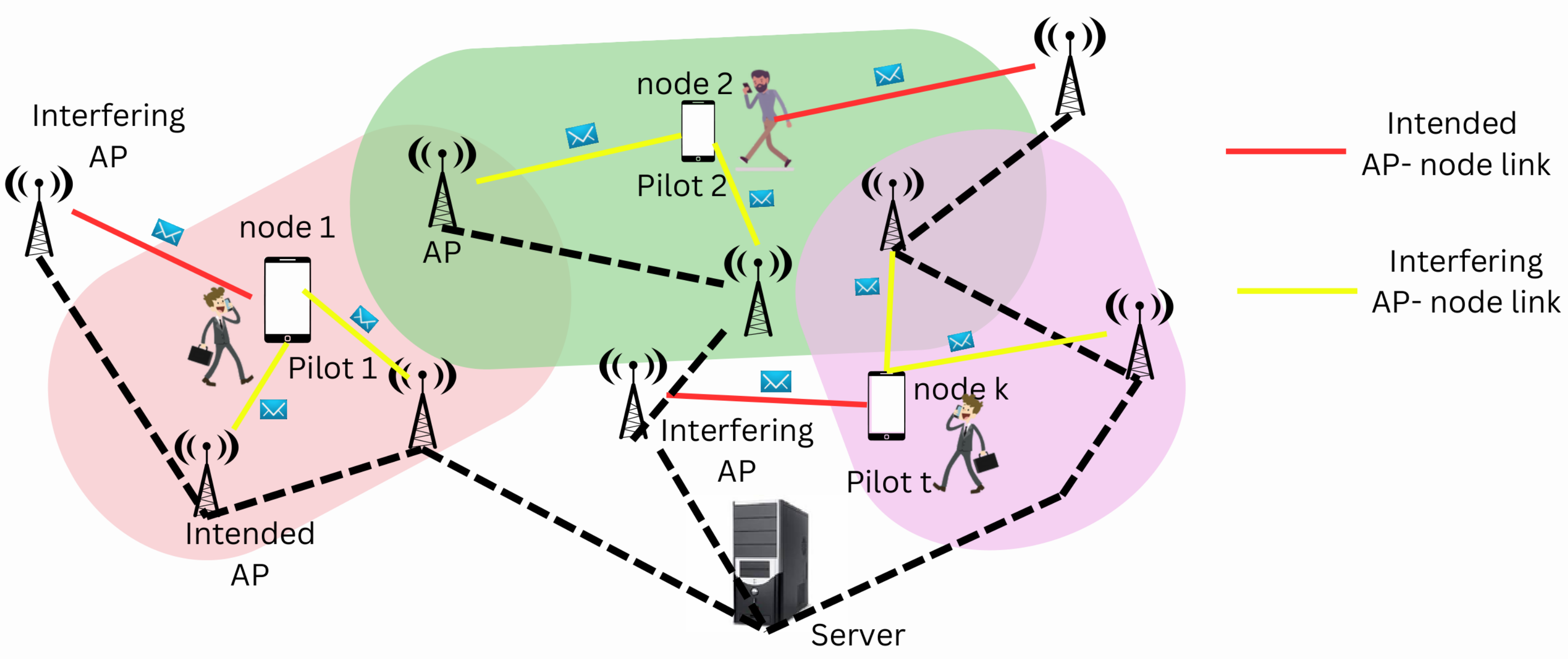


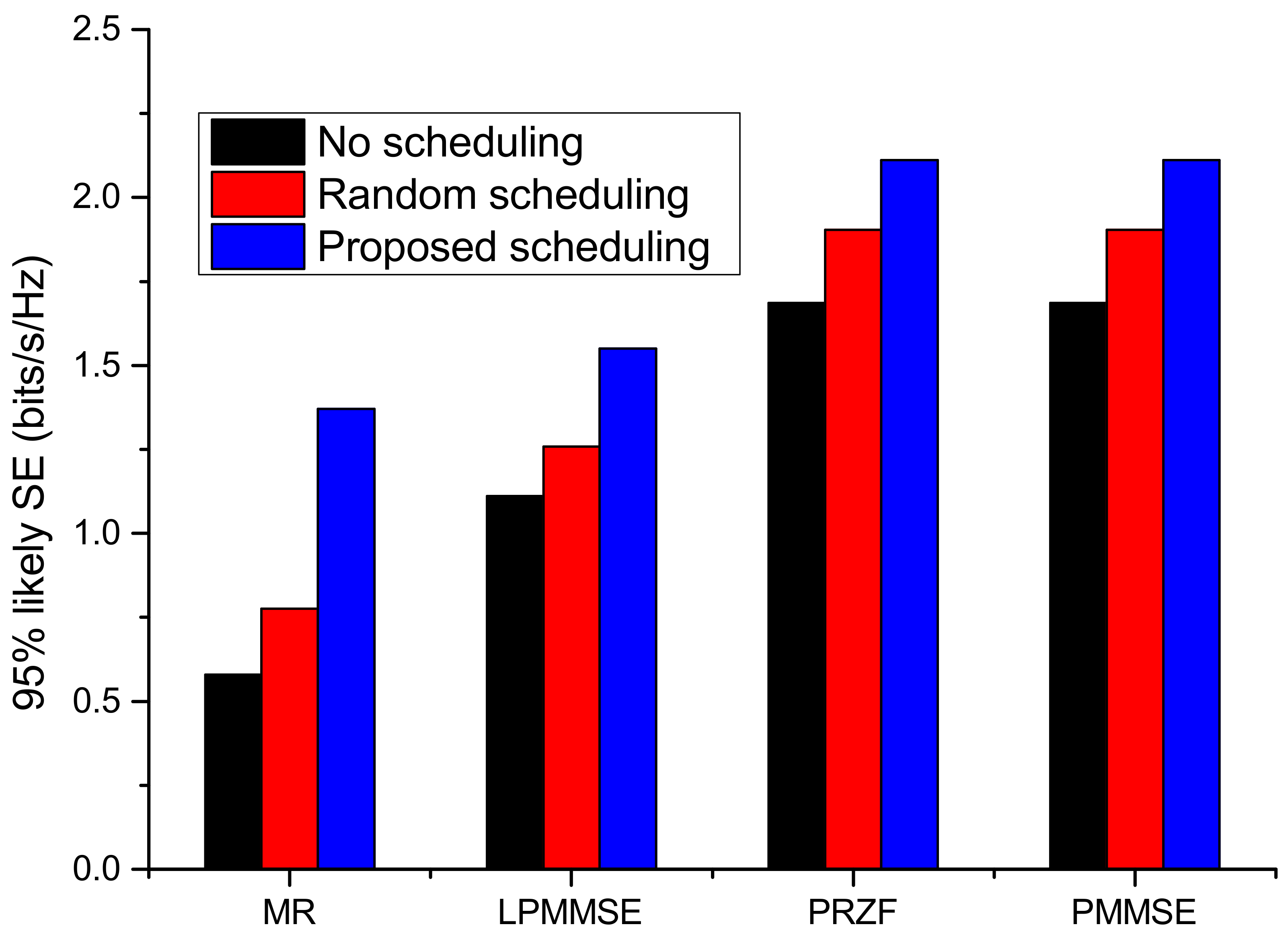

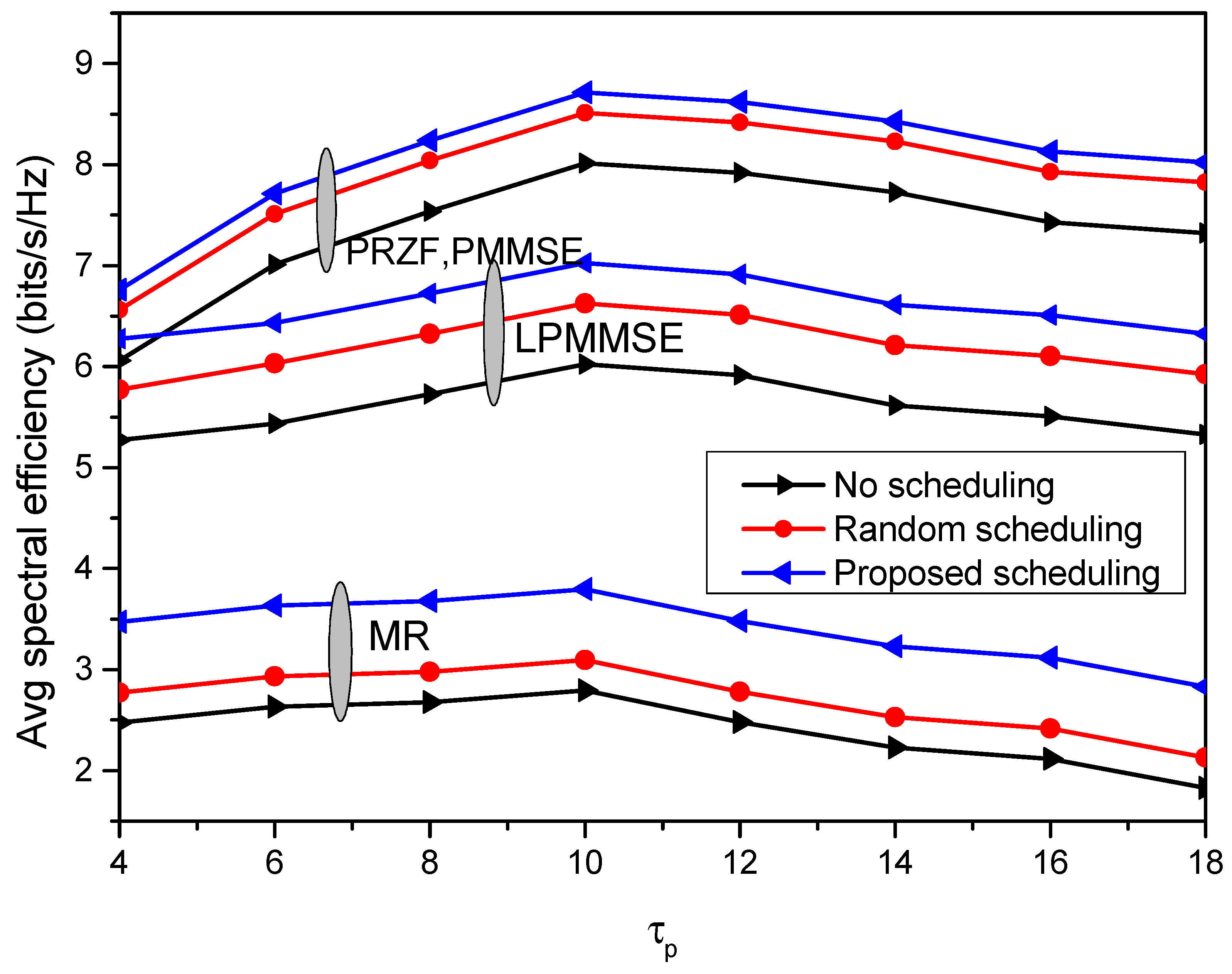
| Notation | Description |
|---|---|
| L | Number of APs |
| N | Number of antennas at each AP |
| K | Number of user nodes |
| Path loss exponent | |
| Transmit power of user k | |
| Pilot length | |
| A set of pilot sequences | |
| Transmitted signal | |
| Set of APs serving node k | |
| Receiver noise | |
| Receiver noise during pilot transmission phase | |
| Channel coefficients between node k and AP l | |
| Estimated channel coefficients | |
| Large scale fading coefficients | |
| Distance between AP l and node k | |
| Precoding vector | |
| Received downlink signal | |
| Set of nodes served by AP l | |
| Spatial correlation matrix | |
| Correlation matrix of the received signal | |
| Error correlation matrix | |
| Set of interfering APs of node k | |
| Interfering nodes to node k | |
| Interference metric |
| Parameters | Value | Parameters | Value |
|---|---|---|---|
| N | 4 | L | 50 |
| K | 40 | m | |
| 10 | 100 mW | ||
| 200 | 100 mW | ||
| B | 20 MHz | dBm | |
| 100 KHz | 1 ms |
Disclaimer/Publisher’s Note: The statements, opinions and data contained in all publications are solely those of the individual author(s) and contributor(s) and not of MDPI and/or the editor(s). MDPI and/or the editor(s) disclaim responsibility for any injury to people or property resulting from any ideas, methods, instructions or products referred to in the content. |
© 2023 by the authors. Licensee MDPI, Basel, Switzerland. This article is an open access article distributed under the terms and conditions of the Creative Commons Attribution (CC BY) license (https://creativecommons.org/licenses/by/4.0/).
Share and Cite
Taneja, A.; Alqahtani, N.; Alqahtani, A. Interference Aware Resource Control for 6G-Enabled Expanded IoT Networks. Sensors 2023, 23, 5649. https://doi.org/10.3390/s23125649
Taneja A, Alqahtani N, Alqahtani A. Interference Aware Resource Control for 6G-Enabled Expanded IoT Networks. Sensors. 2023; 23(12):5649. https://doi.org/10.3390/s23125649
Chicago/Turabian StyleTaneja, Ashu, Nayef Alqahtani, and Ali Alqahtani. 2023. "Interference Aware Resource Control for 6G-Enabled Expanded IoT Networks" Sensors 23, no. 12: 5649. https://doi.org/10.3390/s23125649
APA StyleTaneja, A., Alqahtani, N., & Alqahtani, A. (2023). Interference Aware Resource Control for 6G-Enabled Expanded IoT Networks. Sensors, 23(12), 5649. https://doi.org/10.3390/s23125649






